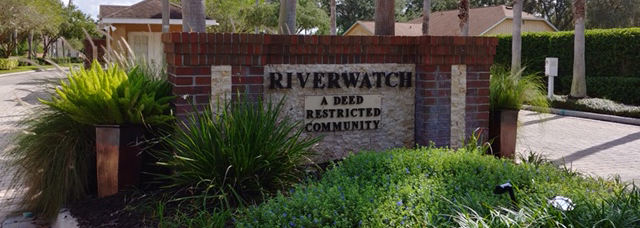ACC Amendment for Residential Playground Equipment
Purpose:
This amendment provides rules and guidelines for the design, construction, and placement of residential playground equipment within the River Watch community.
Definitions:
Residential Playground Equipment: Any permanent or semi-permanent external structure on a homeowner’s property that exists for the purpose of providing entertainment or exercise for children. (Note: Blow-molded (plastic) playsets are defined as toys and are not governed by this addendum. However, they are governed by the standard guidelines for property maintenance.)
Homeowners Residence: The residence (house) is the main building located on a plot of land within the River Watch community.
ACC: River Watch Architectural Control Committee.
Rectangular Plan-form: The smallest rectangle that can enclose the perimeter of an object with no protrusions extending outside that rectangle.
General Guidelines: (applicable to all type of residential playground equipment)
All residential playground equipment should be designed, located, built and maintained in accordance with the Consumer Product Safety Commission Document #323. “Home Playground Safety Tips”
All residential playground equipment must be designed and constructed in accordance with all state and local laws, codes, and regulations.
All residential playground equipment shall be sited to the rear of property lots where applicable. Reasonable setback from property lines and fences shall be maintained for both child safety and privacy for neighbors. Actual offset distance will vary depending on the height of any landings on the playground equipment and configuration of any swings or other non-stationary attachments. (See CPSC Document #323)
Allowable materials for residential playground equipment include: Pressure-treated wood, Cedar, Redwood, Composite materials (ex: Trex). Wood products shall have a protective stain or coating applied.
All residential playground equipment that cannot be removed and stored inside during inclement weather must be securely anchored to prevent it from becoming a potential projectile during a storm or hurricane.
Any canopies for residential playground equipment shall be a solid color (dark blue or dark green preferred). Wood canopies are permitted but must be shingled to match the homeowner’s residence.
The maximum permissible height of residential playground equipment shall be 10’ above grade. In the event of a sloped site, the reference for the maximum height shall be the highest end of the sloped area under the playground equipment. The maximum height assessment includes any ornamentation, decoration or structural elements. (Example: canopies, flags, fire poles, etc)
The maximum rectangular plan-form for residential playground equipment shall not exceed 175 Square Feet.
All residential playground equipment shall be set level & plumb (where applicable).
Treehouses are not permitted.
Residential playground equipment cannot be located in conservation or conservation setback areas.
Residential playground equipment shall be maintained to the same level as the homeowner’s covenant requires the main dwelling to be maintained. Any rotting wood or peeling paint must be promptly replaced, repaired &/or re-painted. Discolored, fraying or torn canopies must be promptly repaired or replaced. Rusted or corroded components must be cleaned, repainted and/or replaced as needed. The general intent of this section is to ensure that the residential playground equipment is properly maintained and does not become an eyesore to the community as a whole or a safety hazard to our children.
Additional Submission Requirements:
Submissions for approval of residential playground equipment shall include the following information in addition to the submission form:
1) A copy of the homeowner’s property plot showing the location and orientation of the proposed residential playground equipment, as well as the boundary of any mulched areas in relation to the proposed playground equipment. The residential playground equipment should be depicted as close to scale as possible.
2) An elevation view, photograph or sketch of the residential playground equipment clearly showing what the proposed structure will look like including any accessories (optional play pieces).
3) Color samples or pictures denoting the colors proposed for the structure, canopies, and accessories.
